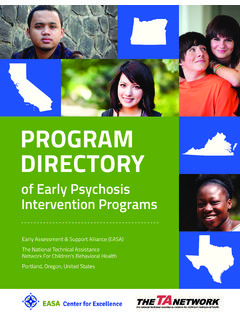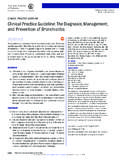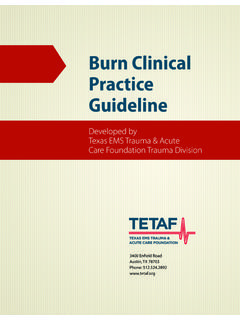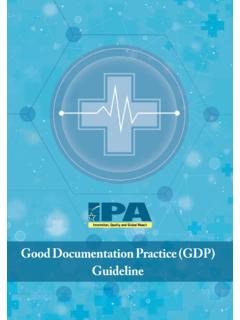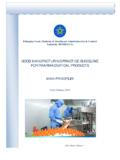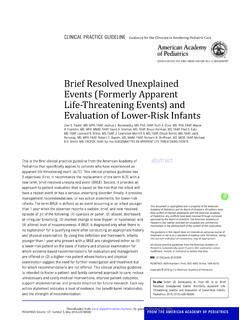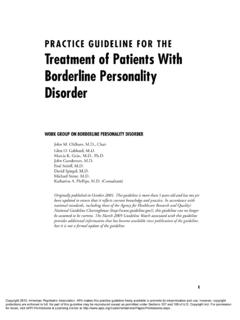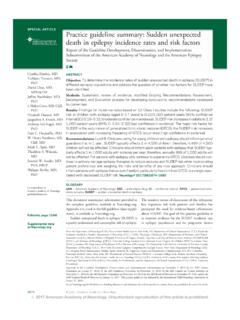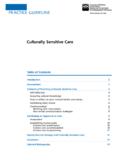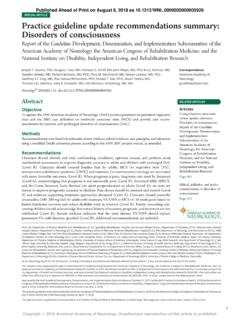Transcription of Practice Guideline Writing Committee Members - EASA
1 Practice guidelines FOR OREGON EARLY ASSESSMENT AND SUPPORT ALLIANCE (EASA) Thank you to the following individuals for their contributions in the development of this document: Practice Guideline Writing Committee Members : Chair: Ryan Melton, PhD LPC ACS Phillip Blea, LCSW Katherine A. Hayden-Lewis, MA LPC Amy Penkin, LCSW Michelle Roberts, BA Tamara Sale, MA Susan Sisko, MA LPC | Practice Guideline Task Force Members : DeAnn Carr, LCSW, CCEP Judy Cleave, MPH, RN Robert Janz, LPC, CADC1 Damien J. A. Sands, MPA Medical Review Committee : Chair: Robert Wolf, MD Sali Borchman, RN Neil Falk, MD Elaine Gilbert, RN Ann Hamer, PharmD, BCPP Kem Murphy, RN Craigan Usher, MD Occupational Therapy Review Committee : Chair: Sean Roush, OTD, OTR/L Tania Kneuer, OTL Christina Perry, OTR/L TABLE OF CONTENTS Overview of EASA.
2 1 Guideline Systematic Infrastructure .. 3 Guideline Individual and Family Participation in Decision Making .. 6 Guideline At-Risk Focus .. 7 Guideline Community Education and Awareness .. 8 Guideline Access and Screening .. 9 Guideline Assessment and Treatment Planning .. 10 Guideline Family/Support System Partnership .. 12 Guideline Transdisciplinary Team .. 13 Guideline Psychoeducation .. 15 Guideline Counseling .. 16 Guideline Occupational Therapy .. 18 Guideline Supported Employment/Education .. 20 Guideline Psychopharmacological Interventions .. 21 Guideline Nursing Interventions .. 23 Guideline Multi Family Groups .. 25 Guideline Transition.
3 26 Glossary of Terms .. 28 Appendices: Appendix A: Policy on Inclusion in the EASA Network .. 31 Appendix B: Credentialing Process .. 33 Appendix C: Fidelity Checklist .. 36 Appendix D: Phases of Care .. 78 Appendix E: EASA Transition Checklist .. 80 Appendix F: Metabolic Monitoring Flow Chart .. 83 References .. 85 1 guidelines for Oregon Early Assessment and Support Alliance Programs November 2013 Introduction The Oregon Health Authority prioritized the implementation of evidence-based best practices with the goal of minimizing disability associated with schizophrenia-related conditions. The following Practice guidelines provide the framework for systemic change and service implementation.
4 The goal is to provide intervention that maximizes speed and flexibility and minimizes barriers while utilizing a public health approach. The Early Assessment and Support Alliance (EASA) is a systematic effort within Oregon to prevent early trauma and disability caused by schizophrenia-related conditions. The Mid-Valley Behavioral Care Network s Early Assessment and Support Team (EAST) first developed these guidelines in 2004. The program was originally based on the Australian Practice guidelines for Early Psychosis (McGorry et al., 1998, 2010). guidelines from the Substance Abuse and Mental Health Services Administration (SAMHSA) evidenced based practices of multi-family psychoeducation, assertive community treatment, and supported employment (2008, 2009) were added later.
5 In 2008 the guidelines were revised for statewide dissemination through EASA. The EASA model has been informed by McFarlane s Family Aided Community Treatment model (McFarlane, Stastny, & Deakins, 1992) as well as international Practice guidelines (International Early Psychosis Association Writing Group, 2005) and British guidelines developed as part of the national Initiative to Reduce the Impact of Schizophrenia (IRIS) ( ). The 2013 guidelines are a culmination of international research, revisions in the Australian and international directives, feedback from EASA clinicians and participants, and emerging research from experts in the field of early psychosis. According to the World Health Organization (WHO), schizophrenia, along with bipolar disorders and depressive disorders, is one of the ten leading causes of disability worldwide (2001).
6 Schizophrenia is of particular concern because the typical age of onset occurs during the key developmental stage of adolescence or young adulthood. Onset at this stage, without early intervention, causes disability that often persists throughout the individual s life (Killackey & Jung, 2007). Indeed, research suggests that the early period of illness (the first two to five years) is a critical period (Nordentoft et al., 2008) that may impact the long-term level of disability. Symptoms associated with schizophrenia-related conditions can create rapid and devastating consequences for individuals, families and 2 communities. Access to appropriate treatment is critical to prevent unnecessary trauma, hospitalization, and disability.
7 The optimal treatment setting is the individual s community (Fitzgerald & Kulkarni, 1998). Thus, EASA works to prevent these consequences through community mobilization and education, early identification, proactive outreach and engagement, and evidence-based treatment and support. The voices and needs of individual and family participants drive all services. EASA is designed as a transitional program. Services in the early phase should equip clients and their families to be effective self-advocates at both individual Practice and systemic levels. The removal of barriers and accommodation of individual needs are priorities in this treatment model. Culturally aware services are highly valued as essential to EASA's foundation.
8 Services are delivered by and to a diverse representation of individuals and groups. EASA's clients and providers across the state represent a range of values, beliefs, identities, stages of life, and lifestyles. Creating culturally aware services is a dynamic and evolving element of service and requires ongoing dialogue, training, self-reflection, and systems improvement. The EASA team is an important assessment and consultation resource for providers and individuals who do not specialize in differential diagnosis of psychotic illness. EASA prevents inappropriate early diagnosis and treatment by providing diagnostic training for providers. The EASA team provides consultation, support, and referrals to appropriate care.
9 The majority of individuals identified by community sources will not have a schizophrenia- related condition; therefore EASA s role includes helping to connect these individuals with the most appropriate services for their needs. Early intervention is a rapidly evolving field. The consensus of what constitutes best Practice continues to develop with new research and experience. These guidelines will need to be periodically revisited and revised. Practitioners and administrators involved with this work will need to maintain awareness of new research and developments. 3 1. Systemic Infrastructure: Successful implementation of early intervention requires significant system-level commitment and intervention in order to support improved practices .
10 Directors, managers, and supervisors will maintain required elements of EASA network inclusion (see Appendix A) and Practice , and are involved in ongoing evaluation to address systemic issues in a culturally- aware manner. Principles: Early intervention requires systemic as well as Practice improvements. Ongoing attention to system redesign is required. a. Early intervention is part of a broader commitment to recovery-oriented system change. To be most effective, ongoing services are consistent with early intervention strategies. b. Mid-managers and clinicians implementing early intervention programs are likely to encounter a range of policy, funding, procedural, and personnel system barriers to the implementation of improved practices .
